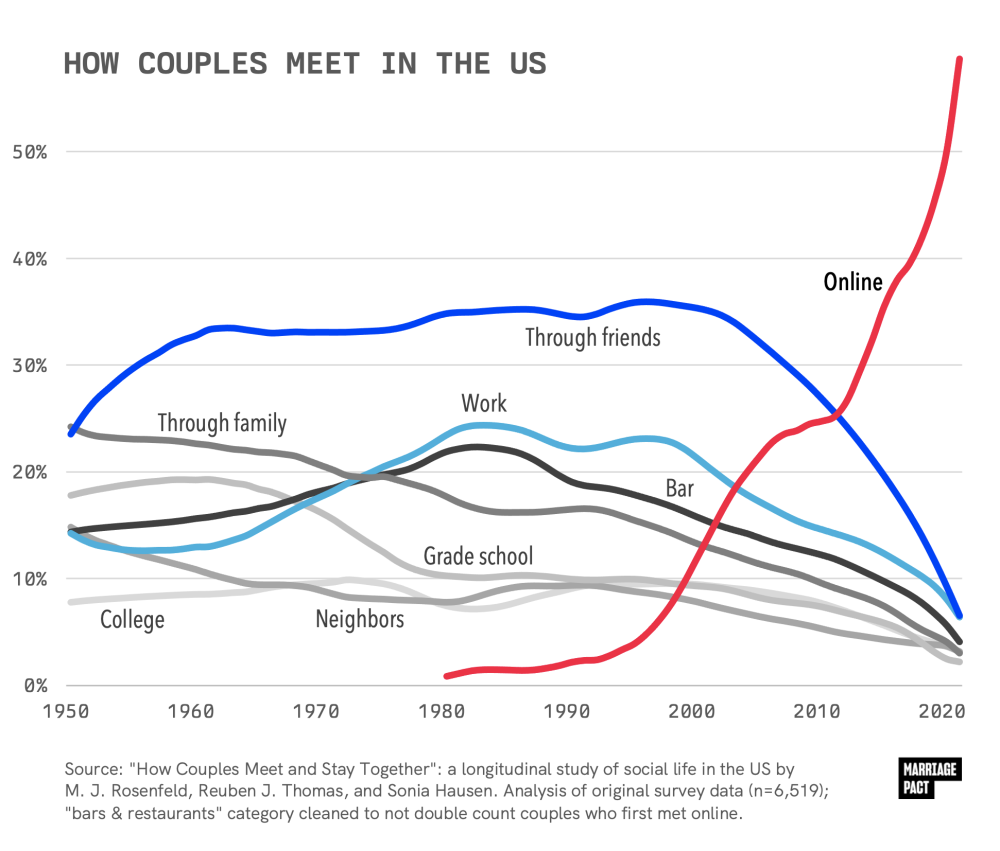Byte Studio
Analysis of How Couples Meet in the US (1950-2020)
Briefing
Description :
This analysis explores longitudinal data on how couples meet in the United States, drawn from survey results spanning 70 years (1950-2020). The data presents several key insights into social patterns, particularly the evolving role of technology in romantic relationships, and shifts in traditional methods of meeting partners.
Rise of Online Platforms as the Primary Method
A significant finding in the data is the steep rise of online platforms as a method for couples to meet, particularly from the early 2000s onwards. Prior to 1995, meeting partners online was virtually nonexistent. However, the data reveals an exponential increase, with online meetings surpassing every other method around 2015. By 2020, approximately 40% of couples reported meeting online, making it the most dominant method for forming romantic relationships. This trend reflects broader societal changes, including increased internet access, the proliferation of dating apps, and the digitalization of social interactions.
Decline in Traditional Social Circles
In contrast to the rise of online platforms, more traditional methods of meeting partners have seen a noticeable decline:
- Meeting through friends: This method was the most common way for couples to meet from the 1950s through the early 2000s, peaking at over 30%. However, starting in the early 2000s, it saw a steady decline, accounting for just under 20% by 2020. The reduction in reliance on personal social circles may be related to the increasing preference for online interactions, where individuals can expand their social networks beyond their immediate friends.
- Meeting through family: This method was once a prominent way for couples to meet, particularly in the 1950s when it accounted for around 20% of all couples. However, it has seen a steep decline since the 1960s, becoming almost negligible by 2020, at under 5%. This shift aligns with the gradual cultural shift away from family involvement in matchmaking.
- Workplace connections: Meeting at work saw a steady increase from the 1950s to around 1980, peaking at around 20%. However, it has since experienced a significant decline, dropping below 10% by 2020. This decline may be linked to evolving workplace norms and the rise of policies regulating office relationships.
- Bars and restaurants: Social gatherings in public spaces, such as bars, have also seen a decline, particularly from the late 1990s onwards. By 2020, meeting in such environments had dropped to around 5%, potentially influenced by changing social habits and the rise of more convenient online methods.
Other Methods of Meeting Partners
- Educational settings: Meeting through college or grade school was once more common, particularly between the 1950s and 1980s. However, by 2020, this method had largely diminished, representing less than 5% of how couples meet. The decline of educational settings as a place to meet partners may be due to both cultural shifts and the increasing age at which people marry or form serious relationships.
- Neighbors: Similarly, meeting through neighbors has seen a continuous decline throughout the 20th century, from nearly 10% in the 1950s to less than 1% by 2020. This trend reflects broader changes in community dynamics and the role of proximity in social relationships.
Conclusion
The data illustrates a profound transformation in the ways couples meet over the past 70 years in the United States. Most notably, it highlights the rise of the internet as the dominant medium for initiating romantic relationships. Concurrently, there has been a sharp decline in traditional methods such as meeting through family, friends, or workplaces. These shifts correspond to broader societal changes, including increased reliance on digital communication, changing workplace norms, and evolving social interactions within communities. As technology continues to evolve, these trends may further shape the future of how relationships are formed.





